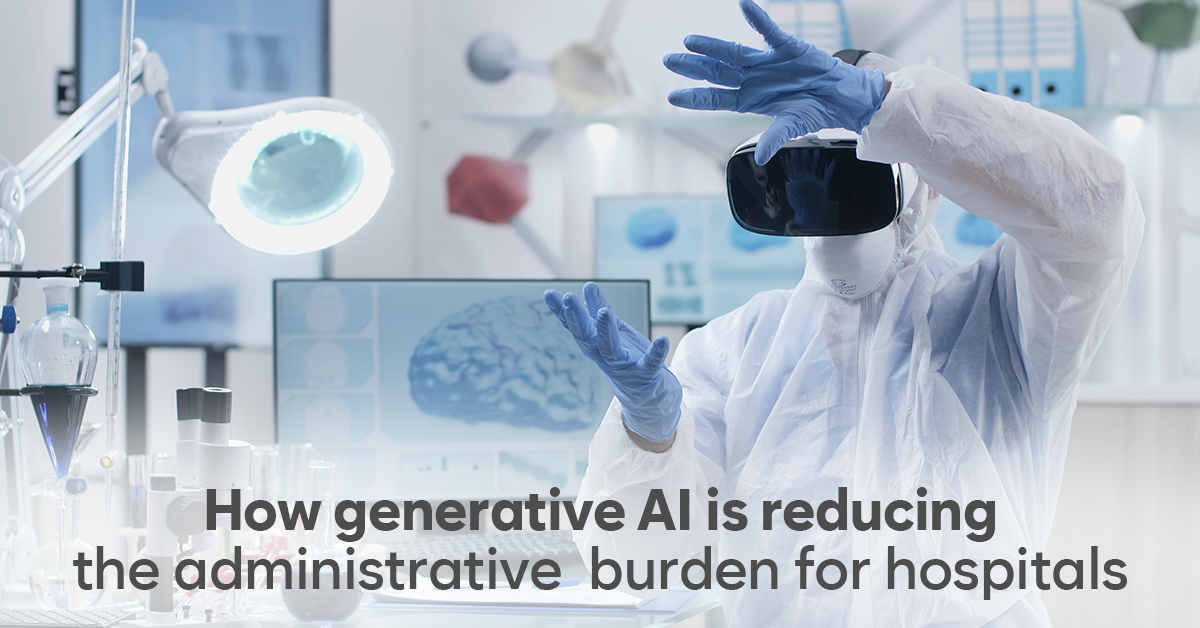In the ever-evolving landscape of healthcare, the role of technology, specifically generative artificial intelligence (AI), has become increasingly significant. One area where this transformative technology is making a substantial impact is in reducing the administrative burden for hospitals.
As healthcare facilities grapple with complex patient data, regulatory requirements, and operational challenges, generative AI is emerging as a powerful ally, streamlining processes, and enhancing overall efficiency.
1. Automated Documentation and Data Entry
One of the primary challenges that hospitals face is the enormous volume of documentation and data entry required for patient records, billing, and compliance. Generative AI systems, equipped with natural language processing capabilities, are revolutionizing this aspect of healthcare administration. These systems can automatically transcribe voice notes, convert handwritten documents into digital formats, and extract relevant information from diverse sources.
By automating these mundane tasks, generative AI significantly reduces the time and effort spent on manual data entry. This not only enhances the accuracy of records but also allows healthcare professionals to focus more on patient care rather than being bogged down by administrative chores.
2. Streamlining Appointment Scheduling and Patient Communication
Appointment scheduling can be a logistical nightmare for hospitals, often leading to inefficiencies and patient dissatisfaction. Generative AI is stepping in to optimize this process by offering intelligent appointment scheduling systems. These systems analyze historical data, patient preferences, and physician availability to generate optimized schedules, minimizing waiting times and maximizing resource utilization.
Moreover, generative AI is improving patient communication by providing automated responses to common queries, sending appointment reminders, and even offering personalized health tips. This not only enhances patient engagement but also reduces the burden on administrative staff who would otherwise spend significant time on routine communication tasks.
3. Fraud Detection and Billing Accuracy
Healthcare billing and insurance claims are notorious for their complexity. Generative AI algorithms are now being employed to detect potential instances of fraud by analyzing patterns and anomalies in billing data. These systems can flag irregularities, ensuring that hospitals receive accurate reimbursement while preventing fraudulent claims.
Additionally, generative AI helps in improving billing accuracy by automating the coding process. By analyzing medical records and extracting relevant information, these systems can generate accurate billing codes, reducing the likelihood of errors and subsequent claim denials. This not only streamlines the revenue cycle but also ensures that hospitals get the right compensation for the services they provide.
4. Regulatory Compliance and Reporting
Hospitals operate in a heavily regulated environment, with a myriad of rules and standards to adhere to. Generative AI aids in navigating this complex landscape by automating compliance checks and generating reports required for regulatory submissions. These systems can keep track of changing regulations, ensuring that hospitals are up-to-date and reducing the risk of non-compliance.
Moreover, generative AI assists in generating detailed reports for internal audits and external inspections. By automating the compilation of necessary documentation, these systems save significant time and resources that would otherwise be spent on manual data gathering.
5. Predictive Analytics for Resource Optimization
Generative AI is not only about streamlining current processes but also about predicting future needs. Predictive analytics powered by generative AI can analyze historical data to forecast patient admission rates, resource utilization, and potential disease outbreaks. This enables hospitals to proactively allocate resources, optimize staffing levels, and enhance overall operational efficiency.
For example, during a flu season, predictive analytics can help hospitals anticipate a surge in patients and adjust staffing and resource allocation accordingly. This not only improves patient care but also ensures that hospitals are well-prepared to handle fluctuations in demand.
Conclusion
As the healthcare industry continues to embrace digital transformation, generative AI is proving to be a game-changer in reducing the administrative burden for hospitals. By automating routine tasks, optimizing processes, and providing valuable insights through predictive analytics, generative AI is empowering healthcare professionals to focus more on patient care and less on administrative complexities.
However, it is crucial to strike a balance between automation and human oversight to ensure ethical use and the highest standards of patient care. As generative AI continues to evolve, its integration into healthcare administration holds immense promise for a future where hospitals can operate more efficiently, ultimately benefiting both healthcare providers and the patients they serve.






